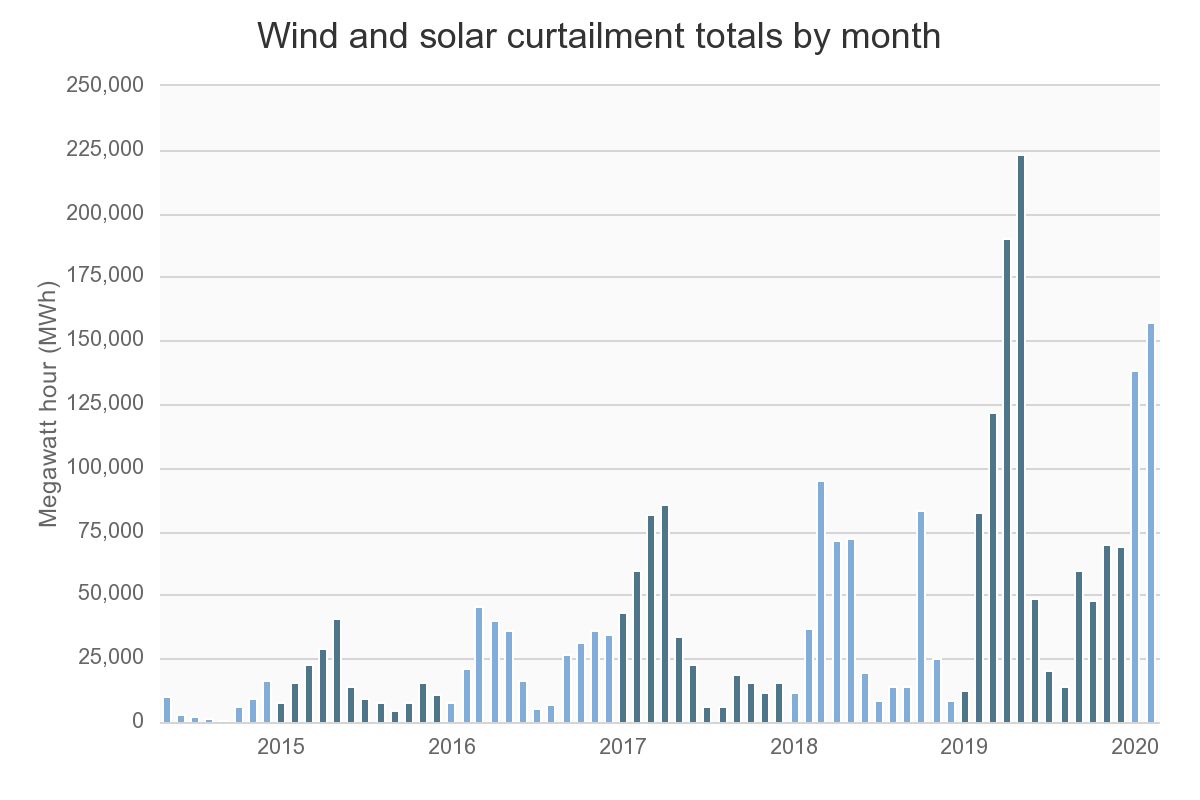In 2020, CAISO curtailed 1.5 million megawatt-hours of utility-scale solar, or 5 percent of its utility-scale solar production because supply exceeded demand during the times solar power was performing. In 2020, solar curtailments accounted for 94 percent of the total energy curtailed in the portion of the grid maintained by the California Independent System Operator (CAISO). Solar curtailments tend to be greater in the spring months when electricity demand is relatively low because of moderate temperatures and decreasing heating and cooling demand. For example, in the early afternoon hours of March 2021, CAISO curtailed an average of 15 percent of its utility-scale solar production.
California’s curtailments have been increasing every year, driven by growth in solar power to meet the state’s aggressive clean energy goals. California had more than 31,800 megawatts of solar as of the end of the first quarter 2021, generating almost 24 percent of the state’s electricity, according to the Solar Energy Industries Association. California has the largest solar market in the United States.
To help meet California’s goal of 50 percent renewable generation by 2025, CAISO plans to add another 1.6 gigawatts of utility-scale solar capacity and 0.4 gigawatts of onshore wind turbine capacity in 2021. Combined, these two technologies represent 44 percent of CAISO’s total capacity additions in 2021.

California’s solar power cannot always be used when it is produced, particularly during sunny, mild spring days when air conditioning is not peaking electricity demand. This drives the supply-demand curve downward from late morning to early afternoon, creating the belly of the state’s “duck curve” imbalance between power being generated and consumed. CAISO has been trying to manage the imbalance for years. Options include exporting the excess power to neighboring states and using batteries to absorb it for discharge later. Those options have only gotten the grid operator partway to managing the imbalances. CAISO has also used energy prices to drive transfers of power from low-price to high-price generating areas, and has encouraged generators that can control their output to ramp down production. The grid operator has also offered “decremental” bids that pay generators to reduce output and has cut generators’ self-scheduled deliveries to the system. As a last resort, CAISO can order generators to go offline through what it terms “exceptional dispatch” orders.
In 2020, CAISO’s Energy Imbalance Market avoided 16 percent of total curtailments by trade within the market, according to reports produced by the operators. The Energy Imbalance Market is a real-time market that allows participants outside of CAISO to buy and sell energy to balance demand and supply.
This year, CAISO is planning to add 2.5 gigawatts of battery storage capacity, according to the Energy Information’s survey of recent and planned capacity changes. Hydrogen production and hydrogen-based energy storage is another area that could help reduce solar curtailments. The hydrogen will be produced by electrolysis using surplus solar and wind power, storing it for later use. Two projects in development are a power-to-gas-to-power project and a project by the Intermountain Power Project (IPP) called IPP Renewed. IPP Renewed focuses on developing renewable-powered hydrogen production and storage capabilities as well as installing natural gas-fired generators capable of using hydrogen.
California Turns to Gas Generators to Avoid Blackouts
Despite the surplus power from solar plants, California is still subject to blackouts. The situation has become dire this summer as a drought has reduced California’s hydroelectric supplies. As a result and despite the state retiring its natural gas plants, California is working on adding several natural gas-fired plants to keep the lights on. The California Department of Water Resources is in the process of procuring five temporary gas-fueled generators that have individual capacities of 30 megawatts that will be installed at existing power plants and which are expected to be operating by the middle of September. The California Energy Commission approved licenses for the emergency gas generators for up to five years. California Governor Gavin Newsom declared a state of emergency for the power grid due to supply shortages during hot summer evenings when solar production declines. The order also temporarily lifted air-quality rules.
Conclusion
President Joe Biden wants a zero-carbon U.S. electricity grid by 2035, yet the state with the most renewable power cannot operate its grid without blackouts and surplus power that is generated when it is not needed. California has used a number of options to fix the problem but none have effectively solved the entire issue. Despite that, the state is still adding solar power capacity to the grid and building five natural gas generators to avoid blackouts that will be operational in mid-September. The irony is that California has been retiring its natural gas generators to meet its goals for carbon neutrality. The result is higher electricity prices for consumers due to perfectly good generators being retired only to have others temporarily installed which must be capitalized. Could better research and planning have been done? Is Biden doing that now or is he rushing into California-like follies?



